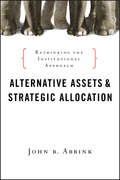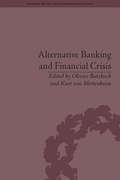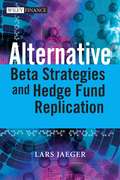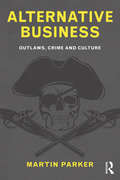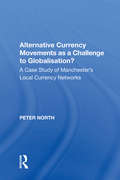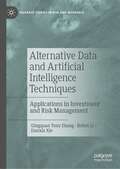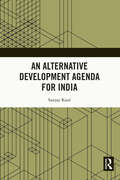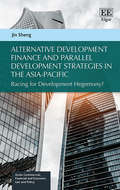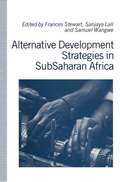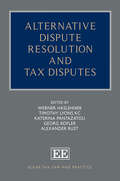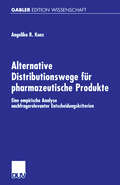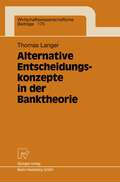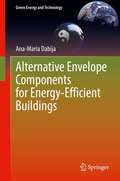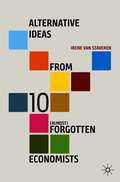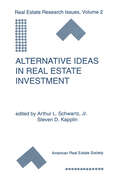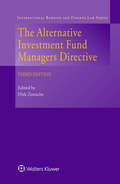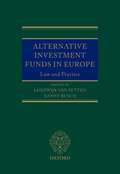- Table View
- List View
Alternative Assets and Strategic Allocation: Rethinking the Institutional Approach (Bloomberg #134)
by John B. AbbinkAn insightful guide to making strategic investment allocation decisions that embraces both alternative and conventional assets In this much-needed resource, alternative and portfolio management expert John Abbink demonstrates new ways of analyzing and deploying alternative assets and explains the practical application of these techniques. Alternative Assets and Strategic Allocation clearly shows how alternative investments fit into portfolios and the role they play in an investment allocation that includes traditional investments as well. This book also describes innovative methods for valuation as applied to alternatives that previously have been difficult to analyze. Offers institutional investors, analysts, researchers, portfolio managers, and financial academics a down-to-earth method for measuring and analyzing alternative assets Reviews some of the latest alternatives that are increasing in popularity, such as high-frequency trading, direct lending, and long-term investment in real assets Outlines a strategic approach for including alternative investments into portfolios and shows the pivotal role they play in an investment allocation Using the information found in this book, you'll have a clearer sense of how to approach investment issues related to alternative assets and discover what it takes to make these products work for you.
Alternative Banking and Financial Crisis (Banking, Money and International Finance #1)
by Olivier Butzbach Kurt Von MettenheimThe recent banking crisis has brought into question the business model used by most large banks. This collection of essays explores the success of ‘alternative banks’ – savings banks, cooperative banks and development banks, using case studies from around the world and discussion of both the historical and theoretical context of banking practices.
Alternative Banking and Financial Crisis (Banking, Money and International Finance)
by Kurt Von Mettenheim Olivier ButzbachThe recent banking crisis has brought into question the business model used by most large banks. This collection of essays explores the success of ‘alternative banks’ – savings banks, cooperative banks and development banks, using case studies from around the world and discussion of both the historical and theoretical context of banking practices.
Alternative Beta Strategies and Hedge Fund Replication
by Lars Jaeger Jeffrey PeaseThere s a buzzword that has quickly captured the imagination of product providers and investors alike: "hedge fund replication". In the broadest sense, replicating hedge fund strategies means replicating their return sources and corresponding risk exposures. However, there still lacks a coherent picture on what hedge fund replication means in practice, what its premises are, how to distinguish di erent approaches, and where this can lead us to. Serving as a handbook for replicating the returns of hedge funds at considerably lower cost, Alternative Beta Strategies and Hedge Fund Replication provides a unique focus on replication, explaining along the way the return sources of hedge funds, and their systematic risks, that make replication possible. It explains the background to the new discussion on hedge fund replication and how to derive the returns of many hedge fund strategies at much lower cost, it differentiates the various underlying approaches and explains how hedge fund replication can improve your own investment process into hedge funds. Written by the well known Hedge Fund expert and author Lars Jaeger, the book is divided into three sections: Hedge Fund Background, Return Sources, and Replication Techniques. Section one provides a short course in what hedge funds actually are and how they operate, arming the reader with the background knowledge required for the rest of the book. Section two illuminates the sources from which hedge funds derive their returns and shows that the majority of hedge fund returns derive from systematic risk exposure rather than manager "Alpha". Section three presents various approaches to replicating hedge fund returns by presenting the first and second generation of hedge fund replication products, points out the pitfalls and strengths of the various approaches and illustrates the mathematical concepts that underlie them. With hedge fund replication going mainstream, this book provides clear guidance on the topic to maximise returns.
Alternative Business: Outlaws, Crime and Culture (Routledge Companions In Business, Management And Accounting Ser.)
by Martin ParkerFrom Robin Hood to Jack Sparrow from Pirates of the Caribbean, outlaws have been a central part of 800 years of culture. These are characters who criticise the power of those in the castle or the skyscraper, and earn their keep by breaking the law. Outlaws break categories too. They are fact and fiction, opposition and product, culture and economy, natural justice and organized crime. Beginning with Robin Hood stealing from the rich, and covering along the way pirates, smugglers, highwaymen, the Wild West, the Mafia and many others, Martin Parker offers a fresh and exciting insight into the counter culture of the outlaw – one that rebels against the more dominant and traditional forms of economy and organization and celebrates a life free from wage slavery. Alternative Business is a highly readable, entertaining book that will prove a helpful study tool for all students and lecturers working on organizations, cultural studies and criminology.
Alternative Business: Outlaws, Crime and Culture
by Martin ParkerFrom Robin Hood to Jack Sparrow from Pirates of the Caribbean, outlaws have been a central part of 800 years of culture. These are characters who criticise the power of those in the castle or the skyscraper, and earn their keep by breaking the law. Outlaws break categories too. They are fact and fiction, opposition and product, culture and economy, natural justice and organized crime. Beginning with Robin Hood stealing from the rich, and covering along the way pirates, smugglers, highwaymen, the Wild West, the Mafia and many others, Martin Parker offers a fresh and exciting insight into the counter culture of the outlaw – one that rebels against the more dominant and traditional forms of economy and organization and celebrates a life free from wage slavery. Alternative Business is a highly readable, entertaining book that will prove a helpful study tool for all students and lecturers working on organizations, cultural studies and criminology.
Alternative countrysides: Anthropological approaches to rural Western Europe today (PDF)
by Jeremy MacclancyA fresh anthropological look at a central but neglected topic: the profound changes in rural life throughout Western Europe today. As locals leave for jobs in cities they are replaced by neo-hippies, lifestyle-seekers, eco-activists, and labour migrants from beyond the EU. With detailed ethnographic examples, contributors analyse new modes of living rurally and emerging forms of social organisation. As incomers' dreams come up against residents' realities, they detail the clashes and the cooperations between old and new residents. They make us rethink the rural/urban divide, investigate regionalists' politicisation of rural life and heritage, and reveal how locals use EU monies to prop up or challenge existing hierarchies. They expose the consequences of and reactions to grand EU-restructuring policies, which at times threaten to turn the countryside into a manicured playground for escapee urbanites. This book will appeal to anyone seriously interested in the realities of rural life today.
Alternative Currency Movements as a Challenge to Globalisation?: A Case Study of Manchester's Local Currency Networks
by Peter NorthOver the past 15 years, local money networks, which are essentially trading networks using a community-created currency, have emerged in countries as far apart as Argentina, Australia and New Zealand, Canada and the US, continental Europe and Japan. They range from Local Exchange Trading Schemes (UK), to Time Dollars (US), Green Dollars (New Zealand, Australia and Canada), Trading Circles (Hungary), Barter Networks (Argentina) and Talents (Germany). Drawing on an ethnographic case study of alternative currency movements in Manchester, UK, this book provides an analysis of the motivations, aims, successes and failures of alternative currency networks. It also raises questions such as the contribution of the alternative currency movement to current debates about alternatives to neoliberalism. While it is theoretically informed, critical and grounded in fieldwork, it is also sympathetic to the political aims of the protagonists and cognisant of the non-economic benefits that arise from their development.
Alternative Currency Movements as a Challenge to Globalisation?: A Case Study of Manchester's Local Currency Networks
by Peter NorthOver the past 15 years, local money networks, which are essentially trading networks using a community-created currency, have emerged in countries as far apart as Argentina, Australia and New Zealand, Canada and the US, continental Europe and Japan. They range from Local Exchange Trading Schemes (UK), to Time Dollars (US), Green Dollars (New Zealand, Australia and Canada), Trading Circles (Hungary), Barter Networks (Argentina) and Talents (Germany). Drawing on an ethnographic case study of alternative currency movements in Manchester, UK, this book provides an analysis of the motivations, aims, successes and failures of alternative currency networks. It also raises questions such as the contribution of the alternative currency movement to current debates about alternatives to neoliberalism. While it is theoretically informed, critical and grounded in fieldwork, it is also sympathetic to the political aims of the protagonists and cognisant of the non-economic benefits that arise from their development.
Alternative Data and Artificial Intelligence Techniques: Applications in Investment and Risk Management (Palgrave Studies in Risk and Insurance)
by Qingquan Tony Zhang Beibei Li Danxia XieThis book introduces a state-of-art approach in evaluating portfolio management and risk based on artificial intelligence and alternative data. The book covers a textual analysis of news and social media, information extraction from GPS and IoTs data, and risk predictions based on small transaction data, etc. The book summarizes and introduces the advancement in each area and highlights the machine learning and deep learning techniques utilized to achieve the goals. As a complement, it also illustrates examples on how to leverage the python package to visualize and analyze the alternative datasets, and will be of interest to academics, researchers, and students of risk evaluation, risk management, data, AI, and financial innovation.
An Alternative Development Agenda for India
by Sanjay KaulThis book provides a revamped, transformative, and fiscally sustainable developmental agenda for India to radically improve the well-being and livelihoods of its citizens. Grounded in a ‘people first’ approach, this alternative agenda focuses on seven vital development and inter-connected areas, including health, education, food and nutrition, child development, gender, livelihood and jobs, and urbanization. The volume highlights the systemic issues plaguing these sectors and offers pragmatic and implementable solutions to address them. The author takes cognizance of the COVID-19 pandemic and draws attention to the limitations of the current public policies and suggests cost-effective interventions and strategies that focus on the poor. The volume discusses crucial themes of universalizing healthcare, battling malnutrition and food insecurity, ensuring quality schooling, unshackling gendered mindsets, enhancing livelihoods and improving the urban quality of life to spell out a pragmatic and workable development agenda for India. Accessible and reader-friendly, the book will be an essential read for scholars and researchers of development studies, economics, public policy, governance, development policy, public administration, political studies, South Asia studies. It will also be of interest to professionals in the development sector.
An Alternative Development Agenda for India
by Sanjay KaulThis book provides a revamped, transformative, and fiscally sustainable developmental agenda for India to radically improve the well-being and livelihoods of its citizens. Grounded in a ‘people first’ approach, this alternative agenda focuses on seven vital development and inter-connected areas, including health, education, food and nutrition, child development, gender, livelihood and jobs, and urbanization. The volume highlights the systemic issues plaguing these sectors and offers pragmatic and implementable solutions to address them. The author takes cognizance of the COVID-19 pandemic and draws attention to the limitations of the current public policies and suggests cost-effective interventions and strategies that focus on the poor. The volume discusses crucial themes of universalizing healthcare, battling malnutrition and food insecurity, ensuring quality schooling, unshackling gendered mindsets, enhancing livelihoods and improving the urban quality of life to spell out a pragmatic and workable development agenda for India. Accessible and reader-friendly, the book will be an essential read for scholars and researchers of development studies, economics, public policy, governance, development policy, public administration, political studies, South Asia studies. It will also be of interest to professionals in the development sector.
Alternative Development Finance and Parallel Development Strategies in the Asia-Pacific: Racing for Development Hegemony? (Asian Commercial, Financial and Economic Law and Policy series)
by Jin ShengThis insightful book examines the impact of two competing visions of Asian-Pacific economic growth paths and development governance. It discusses law, development and finance in the context of the Indo-Pacific Strategy versus the Belt and Road Initiative (BRI), whilst also comparing parallel development financing systems.Jin Sheng reflects on and connects a series of issues of global significance, such as the economic Cold War, global debt, industrialisation and development in the developing world, and the changing international economic order. In so doing the author posits that the BRI’s ultimate objective is to export China’s development model, which is characterised by a focus on exports, experimentalism, and oversupply of currency. The book also critically examines China’s ambition to dominate the international economic order and set up its own favoured international rules.Alternative Development Finance and Parallel Development Strategies in the Asia-Pacific will be an important read for researchers and policy makers in the fields of law, development and finance in the Asia-Pacific region.
Alternative Development Strategies in SubSaharan Africa
by Frances Stewart Sanjaya Lall Samuel M. WangweThe World Bank and the IMF dominate policy-making in Africa today. This book considers the consistency between their adjustment policies and long-run development needs, with an analysis of country experience. An alternative development strategy is proposed.
Alternative Dispute Resolution and Tax Disputes (Elgar Tax Law and Practice series)
Arbitration has been promoted as the future of tax dispute resolution in recent years in line with the increase in complexity of international tax law. This authoritative book presents existing legal rules on the matter, provides a review of the arguments in favour of tax arbitration, discusses the practical and legal challenges for its wide-spread adoption and compatibility with existing domestic and international norms. It also answers key questions for the practical implementation of a modern tax arbitration system.Key Features:Comprehensive analysis of the existing tax treaty framework and their application to MAP and arbitrationUp-to-date guidance on the best practices in alternative dispute resolution to ensure effective and efficient dispute resolutionOriginal insights from dispute resolution mechanisms found in non-tax areas such as trade and investment lawIn-depth discussion of primary and secondary EU law rules on tax dispute resolution, including implications of EU general principles, fundamental rights and internal market rulesIdentifying some of the new issues in tax arbitration and offering views on how to tackle them in the most appropriate way, this book will be a key resource for tax law practitioners looking for the latest insights on how to navigate the legal framework for alternative tax dispute resolution. Students and academics focusing on commercial and tax law will also benefit from this detailed guide.
Alternative Distributionswege für pharmazeutische Produkte: Eine empirische Analyse nachfragerelevanter Entscheidungskriterien
by Angelika KunzAngelika R. Kunz legt eine detaillierte Analyse alternativer Distributionswege aus Nachfragersicht vor. Theoretisch fundiert identifiziert und bewertet sie relevante Einflusskriterien für das Beschaffungsverhalten.
Alternative Energy Sources and Technologies: Process Design and Operation
by Mariano MartínPresenting a comprehensive analysis of the use of alternative sources of energy and technologies to produce fuels and power, this book describes the energy value chain from harvesting the raw material, (i.e solar, wind, biomass or shale gas) followed by analysis of the processing steps into power, fuels and/or chemicals and finally the distribution of the products.Featuring an examination of the techno-economic processes and integration opportunities which can add value to by-products or promote the use of different sources of energy within the same facility, this book looks at the tools that can make this integration possible as well as utilising a real world case study. The case study of the operation of “El hierro” island is used as an example of the current effort towards more efficient use of the resources available. Tackling head on the open challenges of the supply, the variability of the source and its prediction, the description of novel processes that are being developed and evaluated for their transformation as well as how we can distribute them to the consumer and how we can integrate the new chemicals, fuels and power within the current system and infrastructure, the book takes a process based perspective with such an approach able to help us in the use and integration of these sources of energy and novel technologies.
Alternative Entscheidungskonzepte in der Banktheorie (Wirtschaftswissenschaftliche Beiträge #170)
by Thomas LangerDie moderne Banktheorie ist vom Idealbild des Homo Oeconomicus geprägt. Nicht nur die Banken, sondern auch deren Vertragspartner (Kreditnehmer, Privatanleger) werden als rationale Entscheider modelliert. Dieses Vorgehen ignoriert die vielfältigen verhaltenswissenschaftlichen Erkenntnisse über tatsächliches individuelles Entscheidungsverhalten. In der vorliegenden Arbeit wird gezeigt, daß es sinnvoll und möglich ist, alternative Entscheidungskonzepte in banktheoretischen Modellbildungen zu berücksichtigen. Damit wird ein erster Beitrag zu einer verhaltenswissenschaftlich orientierten Banktheorie geliefert. Nach einer umfassenden Übersicht über Phänomene und Anomalien im individuellen Entscheidungsverhalten werden einige konkrete banktheoretische Problemstellungen angesprochen, bei denen diese Erkenntnisse besonders relevant sind.
Alternative Envelope Components for Energy-Efficient Buildings (Green Energy and Technology)
by Ana-Maria DabijaThis book examines ways of saving energy by using green roofs and facades, solar devices such as building-integrated photovoltaics (BIPV), and thermal solar panels, as components of energy-efficient building envelopes. The author takes an interdisciplinary / multidisciplinary approach to the subject that analyzes several different scientific fields connected to building research—sustainability, sustainable architecture, energy efficiency in buildings, and building envelopes—while approaching other collateral domains, including history, archaeology, botanics, physics, engineering, and landscape architecture. Alternative Envelope Components for Energy-Efficient Buildings will be a welcome resource for researchers, students, and postgraduates in the fields of energy, building materials, and renewable energy, as well as architects, engineers, and specialists in industries related to building products.Looks at the impact of building envelopes on energy usage;Offers readers an introduction to the principles of sustainability;Presents passive and active approaches to using solar devices.
Alternative Exchanges: Second-Hand Circulations from the Sixteenth Century to the Present (International Studies in Social History #10)
by Laurence FontaineExchanges have always had more than economic significance: values circulate and encounters become institutionalized. This volume explores the changing meaning of the circulation of second-hand goods from the Renaissance to today, and thereby examines the blurring of boundaries between market, gifts, and charity. It describes the actors of the market - official entities such as corporations, recognized professions, and established markets but also the subterranean circulation that develops around the need for money. The complex layers that not only provide for numerous intermediaries but also include the many men and women who, as sellers or buyers, use these circulations on countless occasions are also examined.
Alternative Food Networks: An Interdisciplinary Assessment
by Alessandro Corsi Filippo Barbera Egidio Dansero Cristiana PeanoIn recent years, Alternative Food Networks (AFNs) have been a key issue both in the scientific community and in public debates. This is due to their profound implications for rural development, local sustainability, and bio-economics. This edited collection discusses what the main determinants of the participation of operators – both consumers and producers – in AFNs are, what the conditions for their sustainability are, what their social and environmental effects are, and how they are distributed geographically. Further discussions include the effect of AFNs in structuring the food chain and how AFNs can be successfully scaled up.The authors explicitly take an interdisciplinary approach to analyse AFNs from different perspectives, using as an example the Italian region of Piedmont, a particularly interesting case study due to the diffusion of AFNs in the area, as well as due to the fact that it was in this region that the ‘Slow Food’ movement originated.
Alternative Ideas from 10 (Almost) Forgotten Economists
by Irene van StaverenHow should we address today’s big problems, and what we can take from icons of economics past? How would John Maynard Keynes have resolved today’s debt problem, or how would Adam Smith have assessed the European carbon emission trading market? This book applies the ideas of ten renowned economists (Marx, Minsky, Keynes, Knight, Bergmann, Veblen, Sen, Myrdal, Smith, Robinson) to real world economic problems, directly or indirectly related to the causes and consequences of the 2008 financial crisis. Each chapter presents an economist, and structures the ‘problem’, the ‘insight’ (the economist’s idea), the ‘economist’ (short bio), and two ‘practices’ offering real-world alternatives. This book presents a lively and original approach that will be of interest to economists and non-economists alike, discussing key elements of an economics for a postcapitalist economy and connecting policy insights to real-world problems of today.
Alternative Ideas in Real Estate Investment (Research Issues in Real Estate #2)
by Arthur L. Schwartz Jr. Steven D. KapplinArthur L. Schwartz, Jr. and Steven D. Kapplin The focus of this volume of the ARES Monograph Series is new ideas in real estate investment. Within this volume, empiricial studies, literature reviews, and tutorials examine a broad range of important investment issues. Many new and innovative ideas are presented. This volume should be a rich source of real estate investment ideas for many years to come. Kapplin and Schwartz examine the returns of two types of REITs, as well as that of Master Limited Partnerships (MLP), over the 1987-1989 time period. Their sample consisted of 54 real estate securities; they conclude that these entities did not provide an effective inflation hedge. MLP returns exceeded that of the overall stock market, but the two REIT types did not provide rates-of-return in excess of the marked. An extensive review of the commercial real estate return literature is presented by Fletcher. He focuses upon studies that utilize commingled real estate fund (CREF) data. His detailed overview of the subject provides a much needed synthesis of the current literature. Roulac presents an extensive discussion of the differences in the per spectives of individual versus institutional investors. In his essay, he considers such factors as scale, diversification, and related issues. Addi tionally, he examines a wide range of literature from within academia, 1 INTRODUCTION 2 as well as the opinions of various real estate gurus. He concludes that behavioral factors override economic considerations.
The Alternative Investment Fund Managers Directive
by Dirk ZetzscheIn the ten years since its coming into force, the Alternative Investment Fund Managers Directive (AIFMD), with almost EUR 7 trillion assets under management in its remit, has become an important piece of European regulation complementing the Undertakings for Collective Investment in Transferable Securities (UCITS) and the Markets in Financial Instruments (MiFI) frameworks. This third edition of the most comprehensive and in-depth analysis of the AIFMD and its related European investment fund legislation (including the European Venture Capital Fund Regulation, the European Social Entrepreneurship Fund Regulation, the European Long-Term Investment Fund Regulation and the European Money Market Fund Regulation among others) brings together fund industry experts, fund supervisors, consultants, lawyers and academics to discuss the content and system of the directive from every angle, including its relation not only to the UCITS and MiFI frameworks but also to pension funds, the Sustainable Finance Disclosure Regulation, the Securitization Regulation and the Cross Border Funds Distribution Directive and Regulation, as well as related pieces of tax regulation at the European level. Further, the third edition emphasizes the function of such factors in the financial services value chain as the following: the AIFMD’s approach to robo-advisors; digital asset funds; infrastructure investments in the context of real estate and sustainable investments; risk management; transparency; and impact on alternative investment strategies. Five country reports, focusing on the European Union’s five most important financial centres for alternative investment funds, deal with the potential interactions among the AIFMD and the relevant laws and regulations of France, Germany, Luxembourg, Ireland and The Netherlands. This thoroughly updated edition elaborates on potential difficulties encountered when applying the directive and provides potential solutions to the problems it raises. The book is sure to be warmly welcomed by fund lawyers and consultants, investors and their counsels, fund managers, depositaries, asset managers and administrators, as well as regulators and academics in the field.
Alternative Investment Funds in Europe (Oxford EU Financial Regulation)
The book provides a full and practical review of the impact of the highly controversial European Directive on Alternative Investment Fund Managers, which was adopted after much debate in October 2010 (AIFMD). The AIFMD is intended to be a regulatory response to systematic risks that came to light in the financial crisis and will have a broad and material impact on the manner in which investment managers may operate and offer non-retail funds (including hedge funds, private equity funds, real estate funds and infrastructure funds), which were previously largely unregulated. The AIFMD not only regulates fund managers based in the EU, but also seeks to regulate non-EU managers who seek to offer non-EU funds to EU investors. Accordingly, the AIFMD will impact all fund offerings to professional investors based in the EU, potentially severely limiting the range of investments available to EU pension funds, insurance companies and other institutional investors. The book begins with a detailed review of the AIFMD itself, including the 'Level 2' rules. The bulk of the book consists of chapters that analyse and explain the national implementation legislation of the EU Member States. Through this structure, the work provides the reader with fast-track access to the regulation at European and national level of non-retail EU and non-EU funds and fund managers, which are caught by the AIFMD.
